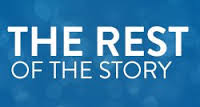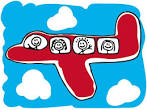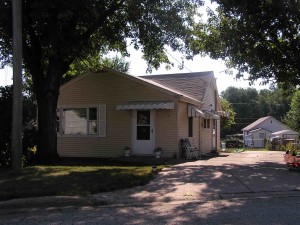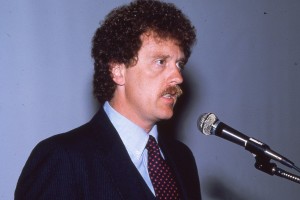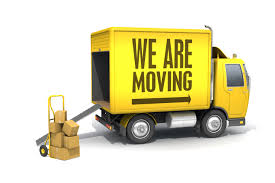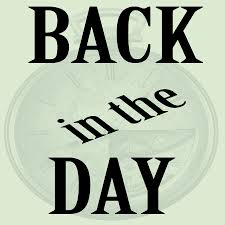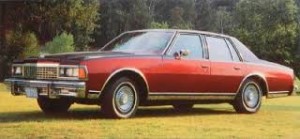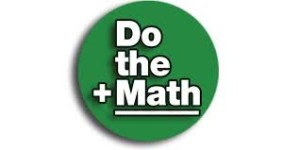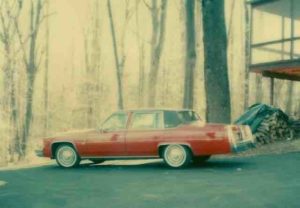How did I get started in racing? Soon you will know the rest of the story!
News flash! I like to travel.
Yes, I like to travel. I always have. I didn’t travel any as a child. I didn’t really begin to travel until I started my business career. One of the biggest benefits of my business travel was that someone else was picking up all of the expenses.
How did you get started with racing?
One of the questions I get most often about my trackchasing hobby is “How did you get started with racing?” There is a two-pronged answer to that question.
In the beginning.
I lived on a small street in a small town in the Midwest growing up. My street was called “Doering” in the town of East Peoria, Illinois. The entire street was home to about ten houses.
Somewhat surprisingly three of those ten houses kept stock cars on the premises. What were the odds of that? In all of the surrounding area, there were not any race teams. However, on MY street there were three race teams! Each of those teams raced at the nearby Peoria Speedway. To this day the Peoria Speedway is still my favorite track even though I have now seen racing at well over 2,000 tracks.
To top off the power of the racing influence on my street was another strange coincidence. If you follow racing you have likely heard of, read and maybe owned a copy of the National Speedway Directory. It’s been known as the “Bible” for the racing fan. Did you know that a fellow by the name of Larry Yard was the originator of what would become the National Speedway Directory? Where did Larry live when I was a kid? At the end of Doering Road! By the way, when I lived there we only new our street as “Doering”. However, today’s official designation is “Doering Road”.
I guess I was “pre-destined” to have a link with racing from that early time. However, I was never mechanical and have zero interest in how racecars worked. I just liked the “looks” of it all and still do. I think that is one of the major reasons I like trackchasing. I like going to a place for the first time and just seeing how things “look”. Of course, I like to do that type of sightseeing all over the world. My curiosity is not just limited to racetracks.
I did drop out of the racing scene for a time.
There was a period of time during college when I pretty much dropped out of auto racing. However, when I began to travel for business at age 23 I was back in it.
I was a “sales guy”.
I was always in the sales department. “Sales” meant travel. I didn’t work an “8-5” job. I was simply responsible for making my sales goal. Making and exceeding the sales goal was the all-encompassing business objective.
I liked the flexibility of sales. I might work all weekend planning and strategizing. I would quite often work evenings with all of the paperwork and analysis.
My bosses all lived hours and maybe states away. We would talk on the phone about the business. They might come to work with me a few times each year. My first ever boss was actually pretty laid back towards work. I remember him telling me “You can call me any time during the evening to talk about the business. However, I eat dinner with my family from 6-7 p.m. I won’t be available to talk then.”
It ain’t done this way anymore.
Times have changed. When was the last time you spent the evening talking to your boss about work? I would routinely spend an hour or two once or twice a week talking to my boss from 7-10 p.m. at night. Then when I changed bosses the workload really ratcheted up for about the next ten years. We were on call 24/7 and I do mean 24/7.
I love flexibility.
However, with all of that commitment I had tremendous flexibility. I was calling on buyers who worked for grocery and drug chains. They were all chained to an office. I think they sometimes looked down on the salespeople calling on them.
However, I think I had the last laugh. I might have a 1 p.m. appointment with them. When I left at 2 p.m. they were stuck in the office for the rest of the day. When I left I might head to the golf course or see a movie! I was only responsible for making my sales goal. I could play golf or go to the movies as much as I wanted. However, when the end of the sales period came I had better have made my sales goal.
Onward and upward.
This made me a pretty driven individual from about 1972-1985. During that time I was promoted to bigger and bigger sales jobs and then sales management jobs. From 1972-1983 we moved from Peoria, Illinois to Cincinnati to Phoenix to Los Angeles to Connecticut to Chicago and back to Los Angeles.
Moving was great….after we left Peoria for the first time. The Peoria area was “home”. No one likes to leave home for good. The first job promotion I was ever offered was to go to Memphis. After much deliberation, I turned down that job. My management was not all that wild about the rejection.
Shortly thereafter, while I was 24 years old, a couple of senior managers took me to lunch. They probably weren’t older than their middle thirties. However, they seemed pretty worldly to me. They had a “heart to heart” talk with me. The message was the next time we offer you a bigger job you should take it. In a few weeks, another offer came along…this time to move to Cincinnati. Since Cincinnati was not home, when the next offer came this time to Phoenix, it was easy to go.
“Back in the day” really WAS different when it came to work.
Back in the 70s “work” was a little different. For the most part men worked outside the home and most women did not. When I was offered a new job and relocation the decision to take it was normally made “over the weekend”. Then Carol and I would make ONE house-hunting trip. On that trip, we would select a neighborhood and a house. We would make an offer and move a couple of weeks later. Carol was seven months pregnant when we moved to Phoenix. In today’s world, NO ONE would move in that circumstance.
There was an excellent reward system for whatever sacrifices we were making.
There was one huge advantage to each of our relocations. Each time I was getting a very nice salary increase. Additionally the company would give us a month’s salary for “moving incidentals”. We always profited on that benefit. I won’t even try to tell you about the “tax gross-up” benefits. The IRS might be reading this!
The company would pay all expenses of getting out of the old house and into the new house. We didn’t pay a penny. I have always believed in “stretching” when time came to buy the next house. That type of thinking had us buying a home for more than $200,000 all the way back in 1979.
On that particular move from the greater Los Angeles area to rural Connecticut, I would be moving from an outside sales job to the “home office” albeit into a national level sales job.
What would you do?
I was told I could keep my current company car, a 1978 Chevy Impala. One of the best benefits ever was having an all-expenses paid company car. I had a reddish one just like shown in the picture.
However, with this move, I was offered the option of having a “car allowance” where I could spend the money from the car allowance on any type of car I wanted. Lots of people would be quite comfortable knowing they could have a new Chevy all expenses paid. I never thought like that. What if I took their car allowance money and paid for my own car?
I always do the math.
I did the math…as I always do. I figured I could buy a brand new 1980 Cadillac Sedan Deville with the car allowance money I was being given. I was only thirty years old. I developed a “contact” that could get me a good deal on a Caddie. I chose the color from a new car brochure “paint chip” while we were still in California.
When the family moved to Connecticut we were directed to a place down in “Jersey” to pick up our new car. I was looking forward to owning my first ever personal car since joining the company eight years ago. The car had all the bells and whistles that a luxurious Cadillac came with back then. Remember, in 1980, the Lexus brand was only a twinkle in the eye of some Japanese engineers.
My Cadillac would come with a maroon exterior and a grey leather interior. That’s why I was so surprised when the guy down in New Jersey pointed over to a fire engine RED Cadillac and said, “There’s your car”. “No,” I told him, “My car is maroon.” A little more discussion informed me the “maroon” paint chip was actually “fire engine red” in reality!
That Cadillac with a diesel engine was one of the worst “pieces of $%#^” I have ever owned in any product category. I went through three diesel engines that were failing all the time. OMG. This experience would put me on a track to begin thinking about leaving domestic cars behind in the rearview mirror…..forever.
There was one other “funny” thing about my owning a brand new fire engine red Cadillac Sedan Deville. My boss, the national sales manager, drove an older somewhat beat-up Honda Civic hatchback to work. Here I would come motoring into the company parking lot, at age 30, with this big red Caddie. That may not have been the best “career move” but I did get promoted to an even bigger job out in the field after only 15 months of working in the home office. Maybe my boss wanted to get rid of me and the big red Caddie from around the home office?
I didn’t leave the domestic car-buying world after my awful Cadillac experience. I ended up buying two Lincoln Town Cars after that Cadillac. I really liked those Lincolns. Then I moved into Mercedes, always brand new until I settled on the Lexus brand. I’ve been a Lexus man since 1999.
I digress.
But I digress just to give you a little background. My early business career had me traveling about two nights each week on average. In order to have better-paying sales jobs I had to go where the business was.
Our company from 1972 through the mid-80s was big on lavish meetings. We went to the biggest and the best resorts for these meetings. I talking about the very best resorts in Bermuda, Florida, Hawaii, Arizona….everywhere in North America.
I had been exposed to racing in my little lower-middle-class neighborhood as a boy. Now a big corporation was paying for me to stay in the best hotels and eat at the very best restaurants any big city could offer.
Racing and luxury a rather nice combination.
How did I combine my racing interest with all of this first-class travel? When our sales meeting ended and everyone headed for home I might “hang around” the area for a day or two. I would seek out racing being held at tracks I had often heard of but never had the chance to visit because they were so far from home.
Usually, our sales meeting would end on a Thursday or Friday. That was perfect. I would simply visit the nearest racetrack for a look-see. This wasn’t always a new track but it was an “expense-free” way to go back to the best racing in America after someone else had paid for my airfare and most other expenses. Over time I discovered I liked “seeing a track for the first time rather than seeing a track for the 10th time”.
Getting more for less with the help of others has been my mantra.
During retirement, I’ve had all kinds of “sponsorship” help to keep my expenses somewhat low. Here’s how I look at that.
If I spend $1,000 on a trackchasing trip any of my fellow competitors would have to spend $3,000 to get what I get. However, they aren’t going to spend that kind of money because they wouldn’t think the trip was worth that kind of money. They are certainly right about that.
However, these folks can’t get $3,000 worth of “stuff” for the thousand dollars I pay. That means they don’t get to do the kinds of trips I do. I’ve told you many times that trackchasing is all about “counting”. As long as my fellow competitors won’t pay $3,000 for a trip and can’t get the trip for $1,000 they will lag behind. There’s nothing wrong with that. Much of the world is ruled by economics.
So this is how I came to become a trackchaser.
What you have just read is a long way of telling you how my interest in trackchasing began and is maintained. As a small boy, I was closely exposed to racing. Then, as a businessman, my hard work was well-rewarded. Part of those rewards was the ability to travel the continent. Those travel opportunities kept me in contact with racing all over the U.S.A. and Canada. Now you know the rest of the story.

